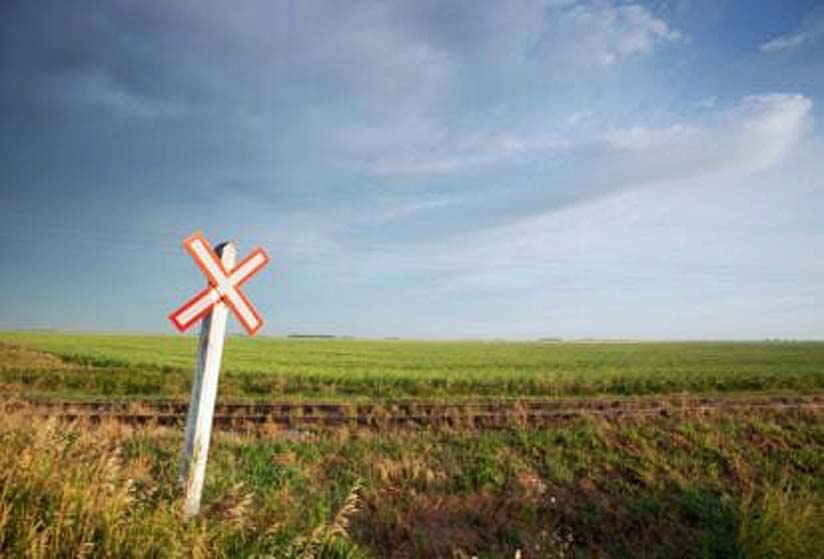

Ottawa Ontario - Some farmer-owned field-to-field grade crossings over Canadian rail lines are now expected to be exempted altogether from
looming federal requirements for safety upgrades.
Proposed amendments to the Grade Crossings Regulations, announced 18 Jun 2021 by Transport Minister Omar Alghabra, this week cleared their 30 day public
comment period.
The amendments are expected to tweak rules which were put in place in 2014 to improve safety at grade crossings, and which required railways, public road
authorities, and owners of private crossings to comply with requirements for existing crossings by no later than 28 Nov 2021 this year.
Given that fast-approaching deadline, Prairie farm groups in December last year called on Ottawa to grant extensions, and to see to it that farmers wouldn't be
left footing the bills for upgrades on their properties.
The COVID-19 pandemic, Alghabra said in June, "has resulted in widespread financial hardship, including for local governments and private owners of grade
crossings."
Transport Canada's proposed amendments, he said, instead "will focus efforts on reducing the risks of preventable accidents at grade crossings while being
mindful of the economic realities."
The need for extensions and exemptions has come up in the past few years, partly on "the challenges in obtaining safety-related information" on
specific grade crossings, Transport Canada (TC) said in a regulatory impact analysis in tbe Canada Gazette for the new amendments.
And from the outset of the 2014 regulations' intended seven-year compliance period, TC said, the bulk of the work to bring grade crossings up to requirements
was expected to happen toward the end of a "five-year municipal planning cycle", in other words, in the summers of 2020 and 2021.
Then the pandemic "led to the loss of the entire 2020 construction season," on top of which affected municipalities now face "budget
constraints, declining revenues, public health priorities, and lack the financial resources to invest in required upgrades."
Thus, with the deadline coming up this fall, about 85 percent of existing public crossings are "currently not compliant with the upgrade
requirements."
New Deadlines
Alghabra's amendments set new compliance deadlines "based on the various levels of risks posed by grade crossings."
Specifically, the amendments grant a one-year extension for "existing public grade crossings which present a higher risk", and a three-year extension
for all other public and all private grade crossings.
That puts the new deadlines at 28 Nov 2022 and 2024 respectively.
But for landowners and others who have "very low-risk" grade crossings where rail lines cut across their land, such as "field-to-field crossings
with minimal train traffic", Alghabra's amendments grant "exclusion" altogether from the Grade Crossings Regulations' construction and
maintenance requirements.
In some cases, railways have had agreements with farmers and other landowners that would have left those landowners on the hook for up to 100 percent of the
costs for the required upgrades, TC said.
Over the last year, the department said, both CN and CP railways had started to write to affected landowners informing them of upcoming bills for work on their
crossings, some of which "can reach as much as $200,000 in cases where warning signals are involved."
These bills from the railways "have attracted considerable media attention, and some of the stakeholders have indicated that they were not properly
informed of the upcoming November 2021 compliance deadline."
The railways, TC said, replied that they were up against delays, both in determining the required upgrades at those crossings, and identifying and informing
the private crossing owners.
As of last month, just 22 percent of private crossings are considered fully compliant.
However, TC said it now has "significantly more data than it did when the Regulations were initially developed," so the department "was able to
establish an objective set of criteria that would capture grade crossings that present a very low risk."
With that, the department estimates, 3,420 grade crossings that were subject to the upgrade requirements could be exempted, including 3,022 private and 398
public crossings, at a total cost savings of about $10.85 million to the railways, road authorities, and landowners involved.
That's out of between 4,000 and 10,000 federally regulated private grade crossings estimated across Canada, about 70 percent of which are in Quebec, British
Columbia, and Ontario.
Alghabra's amendments would "alleviate concerns from private landowners facing large expenditures for upgrading crossings that are subject to minimal
traffic levels," the department said.
It's also expected the amendments would "reduce pressure" on the Canadian Transportation Agency to mediate any "existing and potential disputes
between railway companies and landowners" over who pays how much for the upgrades.
All that said, TC cautioned that if any stakeholders make changes that raise a grade crossing's risk level, for example, increasing train speed or average
daily traffic on a given rail line, they'll need to make sure those upgrades are made within the new time frames, or after those time frames expire, before
they go through with the risk-level changes in question.
In the meantime, TC said last month it will reach out to farmer associations, municipalities, and road authorities to "clearly communicate the proposed
amendments" and encourage "co-operation and sharing of information" with the railways.
Dave Bedard.
 There's an election coming... don't piss-off the farmers!
There's an election coming... don't piss-off the farmers!
(because there was no image with original article)
(usually because it's been seen before)
provisions in Section 29 of the Canadian
Copyright Modernization Act.
